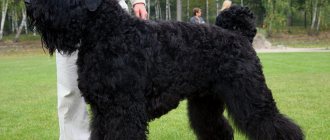Blue eyes in dogs are a rare physical trait that makes their appearance very bright and impressive. When was the last time you saw a dog with blue eyes? Considering the fact that only 5% of all dogs are born with blue eyes, we're willing to bet it's not common.
Sometimes blue eyes are the result of genetic selection, as in huskies, while piebald and white dogs have a special gene that results in blue eyes in puppies. Merle (merle) colored dogs also have a special gene for blue eyes. The genetic pattern in a dog's coat and skin creates the patchy pigmentation. This is a common occurrence in Australian Shepherds.
When a dog inherits two copies of the merle gene, then problems arise. "Double Merle" puppies are often born completely white, blind and deaf, and may have abnormally small eyes or abnormal irises. For these reasons, breeding two carriers of the merle gene is considered bad practice.
Albinism is another reason why dogs are born with blue eyes. Although dogs with blue eyes may be more sensitive to light than dogs with green or brown eyes, they have good vision. However, as dogs age, their eyes become "bluish" which may indicate eye problems such as cataracts or glaucoma, which can affect the quality of the pet's vision.
Now that you're up to date on why dogs are born with blue eyes, let's take a look at the 12 most popular dog breeds that are known to most often have this rare physical trait.
Siberian Husky
Known for its thick coat, high energy and stamina, the Siberian Husky is one of the most popular dog breeds with blue eyes. They are pack dogs , meaning they love to spend time with other dogs. They also need plenty of space to run around and burn off excess energy, so a large yard is a must. The appearance of Siberian Huskies is striking not only with their bright blue eyes, but also with their sharply contrasting white, gray and black fur.
IMPORTANT! These mischievous, agile dogs need an active owner who can keep them in good shape. They also like to dig holes, as their arctic ancestors dug into snow to build protective burrows and hide food.
Prices
The cost of dogs of this breed can range from 5-75 thousand rubles, depending on the status of the seller. A purebred Weimaraner, the price of which is 40 thousand or more, can be purchased at a good kennel. If the future owner plans to make his pet a champion of exhibitions, then the animal will cost him no less than 60 thousand rubles.
In the case where you just need a cheerful and friendly companion for the family, you can buy it for half the price. There is also a budget option - buy Weimaraner puppies second-hand. Sellers usually ask for them from 5 to 15 thousand rubles. These are the prices for animals of this breed throughout Russia, but as for the capital, here they are much higher.
English Setter
The English Setter is a mischievous medium-sized dog, weighing up to 36 kg for males and 25 kg for females. English Setters have a unique mottled coat pattern. Although their eyes are usually brown, setters are sometimes born with blue eyes. English Setters are excellent family dogs. They are also known as the "gentlemen of the dog world" .
WARNING! Along with Dalmatians, English Cocker Spaniels and Bull Terriers, this blue-eyed breed is more likely to be born deaf, according to experts.
Training
Weimaraners are well trained and, with the proper approach, obey their owners unquestioningly. It is important to consider that lack of attention leads to a loss of control over the dog. Weimaraners love to dominate, and if they sense weakness, they will immediately take advantage of the situation.
Puppies require early socialization . If a dog was deprived of contact with people as a child, then it will subsequently develop aggressiveness and distrust. Training unsocialized dogs is a long and difficult process.
In situations where it is impossible to hunt, Weimaraners gladly participate in dog sports competitions - for example, agility.
Weimaraner
The Weimaraner is a medium-sized breed with a smooth silver-gray coat, often with a small white patch on the chest. His eyes are also pale in color - usually an amber or steel blue-gray hue. The American Kennel Club (AKC) recommends that this athletic dog's eyes be checked, along with the hips and thyroid.
Fun fact: Weimaraners have earned the nickname “grey ghosts” for their ability to cleverly disappear from their owner’s sight, especially on foggy days. They are also excellent trackers and are often used in search and rescue missions.
Dalmatian
Known for its white coat with black spots and slender posture, the Dalmatian is a medium to large sized dog with a muscular build and athletic disposition. Their energy makes these graceful dogs ideal companions for avid outdoor enthusiasts , while their loyalty and alertness make them excellent guard dogs. Dalmatians have brown and blue eyes, although the latter are less common.
Did you know that the Dalmatian is the mascot of American fire departments?
American Pit Bull Terrier
Some types of pit bulls are known for their beautiful blue eyes. Blue-eyed pit bulls, although not very common, are very popular throughout the world. The colors include mixtures of brown, yellow and even green eye colors. There are even pit bulls with two different colored eyes. Unfortunately, blue eyes are considered a flaw in the standards. As a result, any blue eyed pit bull is disqualified from showing.
Border Collie
This sweet and intelligent herding dog has a small to medium build and a long, weather-resistant double coat. Although brown eyes are most common in this breed, some Border Collies have blue eyes. They may also have what is called heterochromia (Latin for “different colors”). In congenital heterochromia of the iris, one eye may be entirely blue or have different areas of pigmentation, such as brown and blue areas.
Fun fact: Border Collies often top lists of the smartest dogs in the world. They are also one of the fastest breeds in the world, reaching speeds of up to 48 km/h.
Gray hybrids
While all of the above dogs are beautiful, remember that there are also mixed gray dogs that are solid gray or mixed with white. For this reason, we recommend that you visit the shelters and associations closest to your place of residence to adopt a mongrel gray dog. This way, you'll be giving a second chance to a dog who will thank you for the rest of his life and fight against abuse and abandonment...
If you have adopted a gray dog into your family, you may be wondering what to name it. Luckily, our list of over 150 gray dog names can provide some help.
0
Did you like the article? Share with friends:
You may also be interested
Animal comparisons 0
Dachshund
badger dog in German , is a small and energetic German dog breed with excellent hunting skills (hence its name). Today they are affectionately called "sausages" because of their resemblance to a hot dog: a long body with four short legs. Dachshunds can have long or short hair and typically have chocolate brown eyes. In very rare cases they may have blue eyes. Pay attention to other short-legged dogs that have a pretty appearance and a mischievous character.
IMPORTANT! Although dachshunds can be difficult to train, they are hunters at heart and love to work for reward. Practice with toys and treats for quick success. As with most hounds, the key to success is patience and consistency.
Varieties
There are three breed varieties that you should know about before purchasing a Weimaraner. All of them differ only in color or long fur. The remaining data (appearance and character) do not change.
Basically, there are individuals with hard and short hair, which is smooth to the touch. Another variety boasts long and soft hair - from three to five centimeters. It is less common to find straight-haired dogs. They have a two-layer coat with a thick undercoat and an upper, absolutely smooth, layer of medium length.
Some kennels may offer "blue Weimaraners". These dogs have gray-blue fur and black lips and nose. These are wonderful animals that are best suited to be a family friend, but they cannot take part in exhibitions. Therefore, you can buy a “blue Weimaraner” puppy cheaper than a “regular” one.
Welsh Corgi Cardigan
The Cardigan Welsh Corgi has a similar build to the Dachshund, with a long body and short legs, although this herding breed is slightly larger, ranging from 11.5 to 17.5 kg. Their coats come in a variety of colors, including red and blue merle, and their tail is long and bushy. According to the official Cardigan Welsh Corgi standard, "blue eyes in any coat color other than blue merle are disqualifying."
The cardigan’s wide “smile” is an outward manifestation of his friendly disposition . Affectionate and good-natured, the Cardigan Welsh Corgi gets along well with children, older people, other dogs and even cats.
Fun fact: According to Welsh legend, corgis are enchanted dogs chosen by elves and fairies to "draw their carriages and serve as steeds in battle," and the pattern on the corgi's back and shoulders are the marks of harness and saddle.
Australian Shepherd
This charming member of the herding group is a particularly popular breed of merle dog with green, blue, brown eyes or heterochromia. Australian Shepherds have a medium-length and somewhat coarse coat, they have a short-cropped tail and an agile, muscular build. All this creates a truly striking appearance, and the alert and courageous nature makes Australian Shepherds excellent herders in different climatic conditions.
Did you know that originally bred as hard-working herding dogs, today's Australian Shepherds are often used as police dogs to detect drugs or assist in search and rescue missions, as well as service dogs that help people with disabilities.
German dog
The majestic and noble Great Dane has a lean, slender build and huge, pointed ears. Its coat is usually caramel in color, except for its black muzzle, and it is quite large, ranging from 63.5 to 79.5 kg. When it comes to their eyes, things get a little more interesting. Great Dane puppies are often born with blue eyes , but their color usually changes to amber or brown as they mature. In rare cases, their eyes may remain blue.
Fun fact: In 2011, a Great Dane from Otsego, Michigan named Zeus was listed in the Guinness Book of World Records as the "Tallest Dog in History", standing at 111.8 cm tall and weighing over 70 kg (while standing on his hind legs , he had a height of 220 cm). It is reported that Zeus ate a kilogram of dog food every day. He passed away in 2014 when he was 5 years old.
Nutrition
This breed does not cause allergies, so nutrition, if we are talking about the natural type of feeding, can be varied. The main rule is a balanced diet. Microelements are already included in dry food. But with natural food, the dog may receive an insufficient amount of vitamins. Therefore, supplements are recommended. It is imperative that the composition includes proteins such as meat, sea fish or offal.
Moreover, almost all varieties of meat are recommended, except pork. Complex carbohydrates are also very important. And not only buckwheat and rice, but also oatmeal. Potatoes are undesirable among vegetables, and other products are served boiled or raw, or can be given grated.
Once or twice a week, the dog can be fed with boiled eggs of chickens or quails. The dog will not refuse fermented milk products such as low-fat natural yogurt, kefir or fermented baked milk.
By the way, Weimaraner puppies should consume “sour milk” daily, at least until they are 5-6 months old. But an adult dog can be given kefir and fermented baked milk less often. Otherwise, intestinal disorders may occur. The principle of feeding is that the volume of food should correspond to the size and age of the dog. Weimaraners are prone to overweight and weight gain.
Therefore, owners should have a negative attitude towards “biting” between meals. After eating, it is better to remove the bowl until the next feeding. But the bowl of water should always be in a visible and accessible place for the dog.
Labrador Retriever
The Labrador Retriever is consistently considered one of the most popular dog breeds – and for good reason. They have a naturally sweet and loyal disposition, are easy to train , and are known as one of the smartest dog breeds. This breed comes in three main colors: golden, chocolate and black. Like many of the breeds on this list, they most often have brown or amber eyes. Sometimes - often when mixed with other breeds - chocolate or black dogs with blue eyes may appear in this family.
Did you know that Labradors are actually native to Newfoundland and not Labrador, after which they were named. This water dog was originally used to catch ducks and help fishermen.
Breed characteristics and character
There are several versions regarding the place where the breed originated. According to some sources, the Weimaraner dog has German roots; according to others, the dog comes from France. There is a beautiful legend according to which in the 13th century the first dogs were brought to the French Republic by the king who returned from the Crusade. And he was attracted by the unusual appearance of the four-legged animals - their silver-colored skin and aristocratic appearance.
Among the people, the dog received a name that it still bears today. And it is translated as “silver ghost”. The adjective refers to color, and the noun refers to characteristics: dogs can stalk prey completely silently.
The monarch decided to use the dog as a hunting assistant. Thus, the Weimaraner acquired the function of a gun dog, and a universal one - it chased both large animals and small rodents. Several centuries later, the dogs were recognized as an elite breed in Europe. At one time they lived in palaces.
A new surge in popularity occurred in the second half of the last century. By the way, in the post-war period, the long-haired Weimaraner . The fact is that owners of long pile have been rejected for a long time. But in 1935, at an international exhibition in Germany, these dogs were finally examined and approved.
Dogs received the greatest recognition in America, where the role of a home companion and sometimes a guard was added to the function of a hunter. This breed is often hired as an assistant by law enforcement officers. This is not surprising, since dogs have an excellent sense of smell. They can be trained to acquire smuggled goods and weapons with drugs.
Weimaraner puppy age 3 months
In Russia, the breed began to gain popularity relatively recently, but problems still arise in acquiring dogs for high purposes. If representatives of the pet class can still be purchased without much searching, then the show class will have to be searched hard.
Interesting fact: the breed is considered a chameleon. At birth, the blue wemaraner gradually begins to turn gray and by 12 months acquires a silvery tint. This dog is considered one of the most beautiful among all members of the canine family. The animal’s character is not capricious - the dog will happily respond to any initiative of the owner regarding the game.
He is highly active and loves to run. Accordingly, it requires frequent and long walks with good physical activity. Reviews of the Weimaraner from owners indicate that the dog is not suitable for homebodies and lazy citizens.
Weimaraner on a walk in summer
If a four-legged pet is deprived of physical activity, its character will deteriorate - it will become aggressive and harmful, and will begin to encroach on the owner’s slippers, sofas and other objects. The last option is depression. But if a dog is raised to suit its needs, it will make a good companion.
Bull Terrier
You'll easily recognize a Bull Terrier when you see one! It is a distinguished and unusual-looking dog with an ovoid head , a wide and rounded muzzle, pointed ears and a medium-sized muscular body. Its triangular eyes are often dark brown, but on very rare occasions you may see this white dog with blue eyes. This is more common when crossing a Bull Terrier with a Merle dog.
Fun fact: Bull Terriers were first bred in the 1830s as fighting dogs, likely by crossing the Bulldog with the now extinct White English Terriers and Dalmatians to increase their size. Bull Terriers were considered gladiators in the dog fighting ring and were valued for their strength and tenacity.
Care and maintenance
Despite the fact that the Weimaraner looks well-groomed in the photo , it does not require any special manipulations in relation to its appearance. Due to its short fur, the dog is not intended for frequent bathing.
The Weimaraner is low maintenance
But you still need to keep the skin clean. Therefore, in slush and dirt, breeders recommend putting canvas blankets on the dog and cleaning it with a massage glove. You should monitor your eyes and ears at least once a week by wiping them with a damp swab. There are no particular difficulties with teeth, but special bones from a pet store will be useful for preventing tartar. The claws usually wear out on their own, on asphalt and other surfaces. But in winter they should be trimmed from time to time.
German Shepherd
This large dog breed has a majestic and sophisticated appearance and is also known for its intelligence and intelligence. This is one of the reasons why German Shepherds are an excellent breed for police and military units and why they have a reputation as loyal guard dogs . Their athletic physique and fearlessness also help in their challenging work! Although blue eyes are quite rare for German Shepherds, it can sometimes occur due to genetic variation.
IMPORTANT! Although German Shepherds are capable of adapting to a variety of living situations, their high energy and large size make them more suitable for homes with a large fenced yard. German Shepherds can do well in apartments as long as they get enough exercise every day.
Based on materials from: www.rd.com
Possible diseases
The Weimaraner is a large breed, so their lifespan is shorter than that of small dogs. With proper care and care for this four-legged animal, the life expectancy will be up to 12-13 years. Dog owners should be aware of possible diseases that are typical for this breed.
For example, like other large dogs, the Weimaraner suffers from all sorts of joint problems, the first place among which is hip dysplasia. Problems with the gastrointestinal tract are common. These include bloating and even volvulus.
Another vulnerable spot is the epidermis. Dermatitis is possible, including between the fingers, as well as melanoma and other diseases. Another number of ailments are demodicosis, caused by parasites, mastocyoma (a benign tumor on the skin), as well as lipoma and sarcoma.
Ophthalmological diseases include additional eyelashes, which have the medical name distichiasis, entropion of the eyelid and dystrophy of the ocular cornea.











